Towel Warmer ANSYS Fluent CFD Simulation Training
$60.00 $30.00 Student Discount
- The problem numerically simulates the Towel Warmer using ANSYS Fluent software.
- We design the 3-D model by the Design Modeler software.
- We Mesh the model by ANSYS Meshing software.
- The mesh type is Structured, and the element number equals 475344.
- The Energy Equation is activated to consider convective heat transfer from pipes.
To Order Your Project or benefit from a CFD consultation, contact our experts via email (info@mr-cfd.com), online support tab, or WhatsApp at +44 7443 197273.
There are some Free Products to check our service quality.
If you want the training video in another language instead of English, ask it via info@mr-cfd.com after you buy the product.
Description
Towel Warmer ANSYS Fluent CFD Simulation
The present problem simulates a Towel Warmer ANSYS Fluent CFD Simulation. We perform this CFD project and investigate it by CFD analysis.
A towel warmer is considered a type of radiator used to dry towels in the bathroom, is responsible for heating the bathroom’s interior, and is considered a decorative element.
How it works is not much different from a regular radiator, so this device also supplies the hot water needed to create heating from the central engine room or package.
The hot water circulation in this device’s pipes warms the space and absorbs the environment’s humidity. In this simulation, a towel warmer is designed in which water flows through several rows of pipes with a rectangular cross-section.
The present model is designed in three dimensions using the Design Modeler software. The model is related to a towel warmer that has a radiator structure. The model is 32 cm long and 40 cm high; It consists of 34 rows of pipes with a rectangular cross-section.
The meshing of the model was done using ANSYS Meshing software. The mesh type is Structured. The element number is 475344.
Towel Warmer Methodology
The water flow inside the towel warmer has a velocity of 0.083 m/s and a temperature of 317.15 K.
Also, the pipe walls of this towel warmer have a thermal boundary condition of the type of convective heat transfer, So that the heat transfer coefficient is equal to 250 W/m2K, and the ambient airflow temperature is equal to 298.15 K.
Moreover, the realizable k-epsilon model and energy equation are used to solve turbulent fluid equations and calculate temperature distribution within the domain.
Towel Warmer Conclusion
At the end of the solution process, two-dimensional and three-dimensional contours related to pressure, velocity, temperature, vortex viscosity, and turbulence kinetic energy are obtained.
The contours show that the water flows inside the towel warmer and transfers heat to its surroundings. As a result, the water temperature inside the towel warmer decreases from the inlet to the outlet.

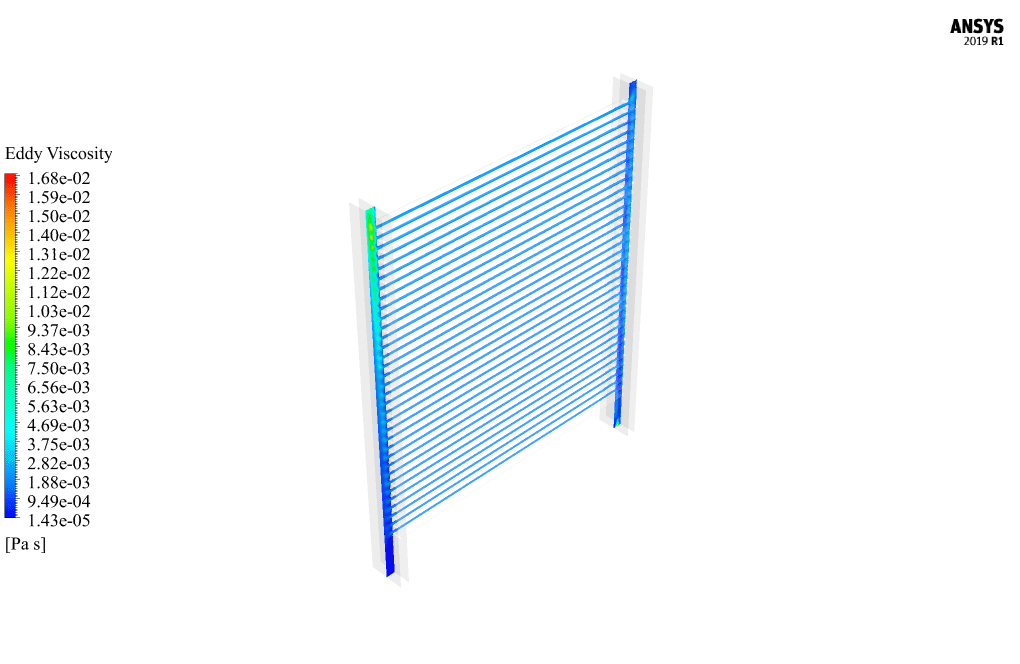
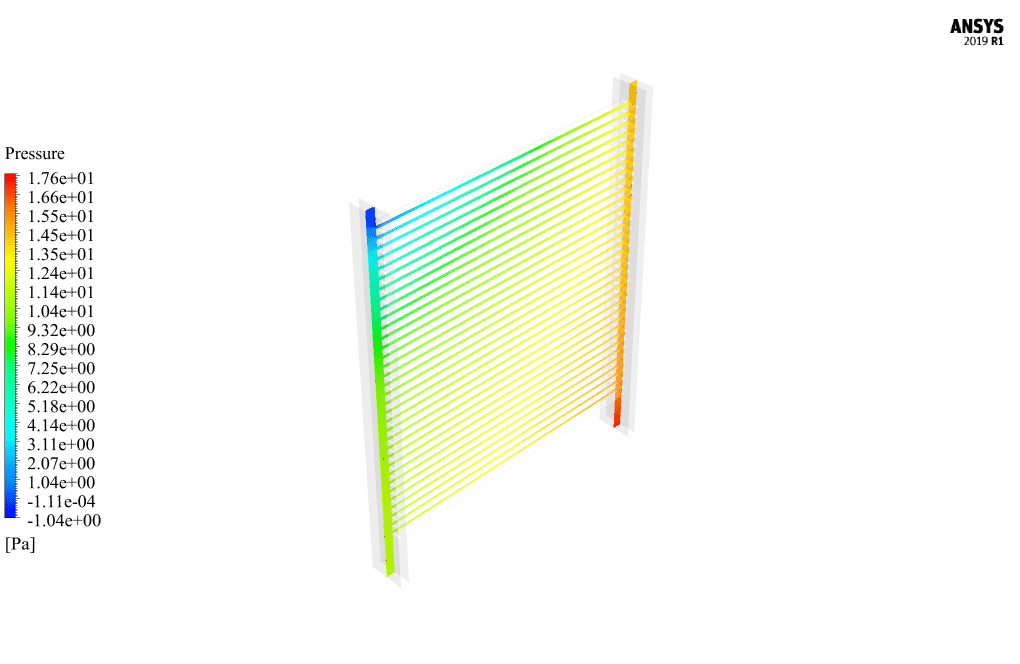
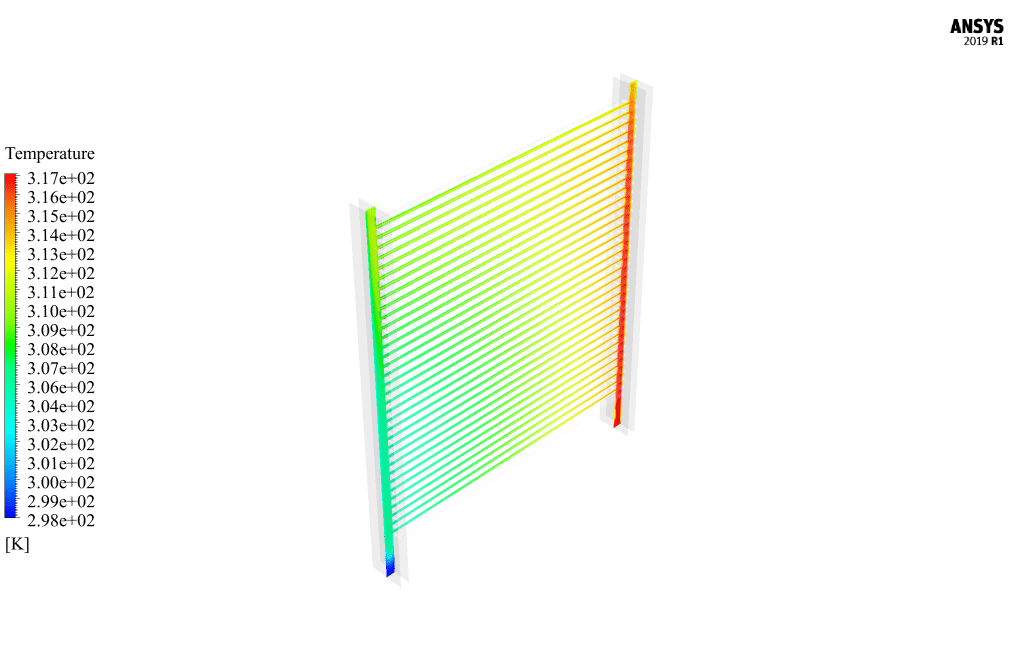
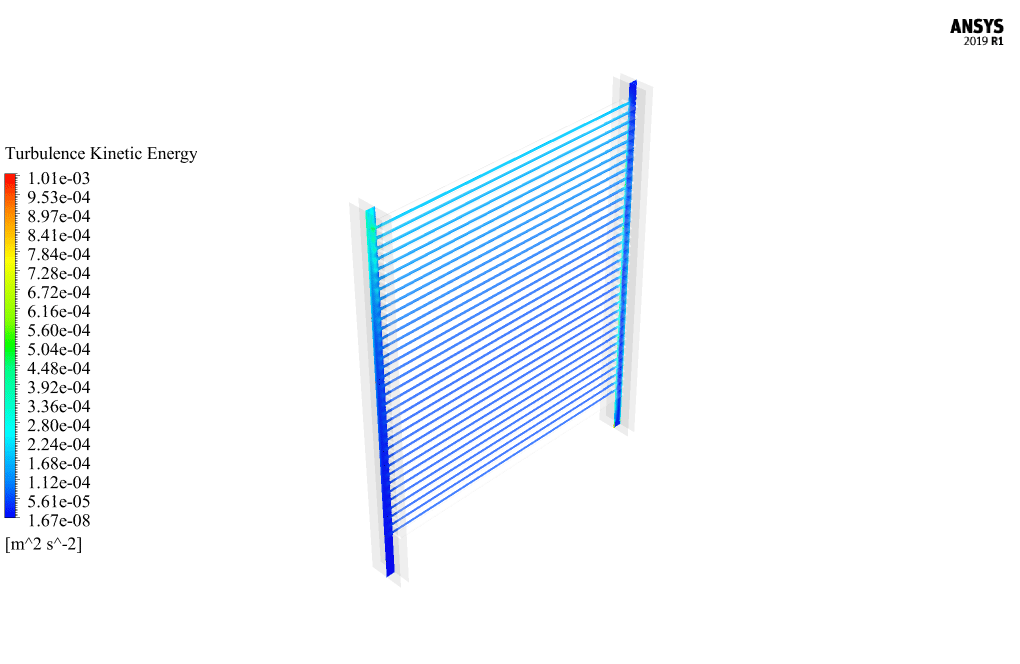
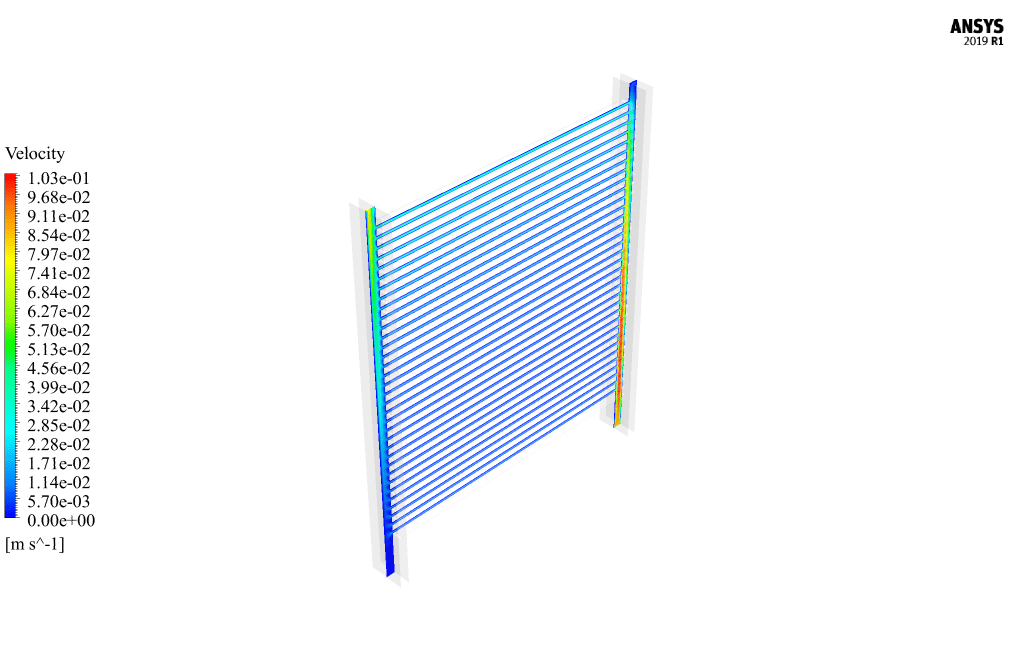

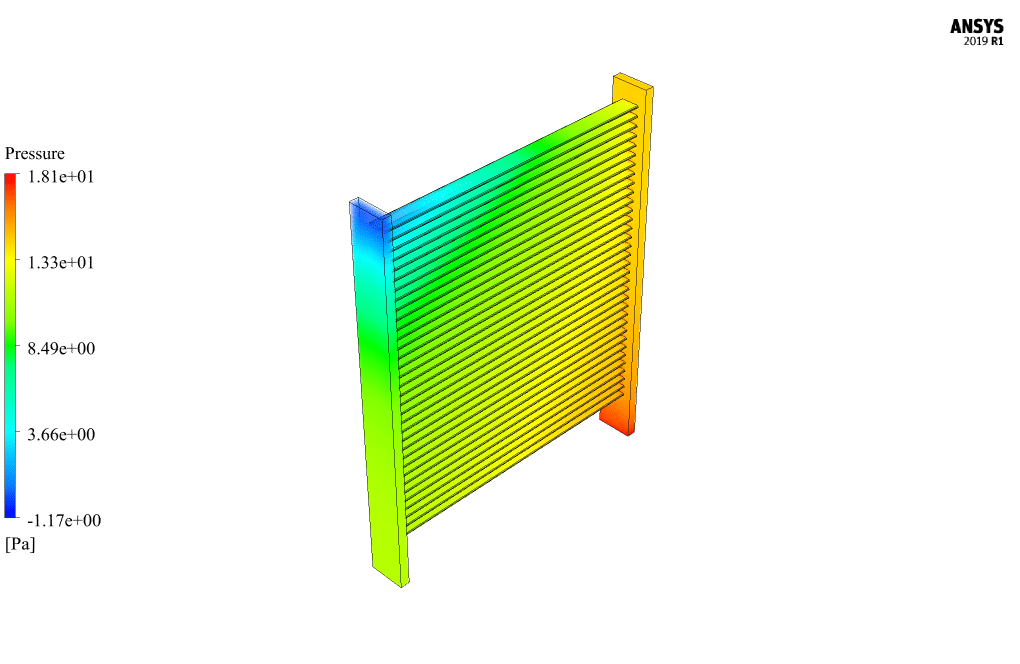
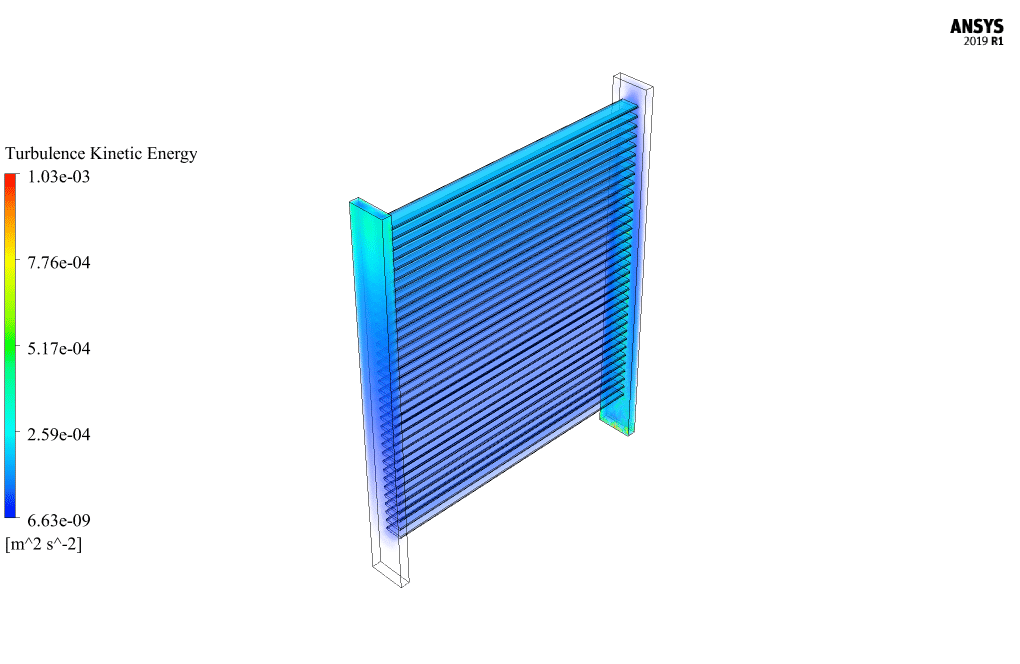
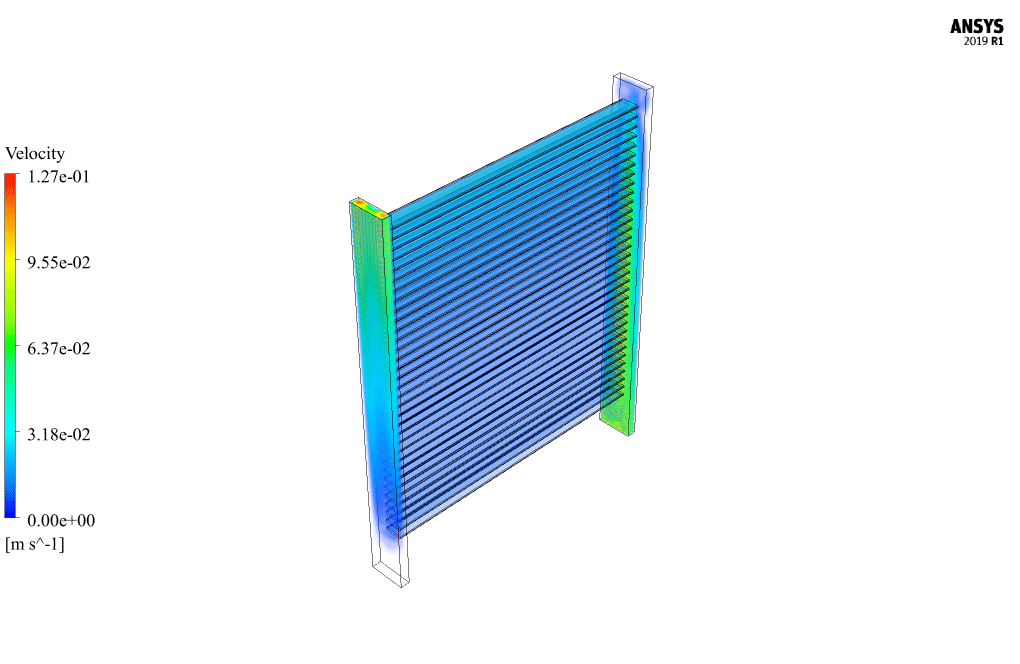
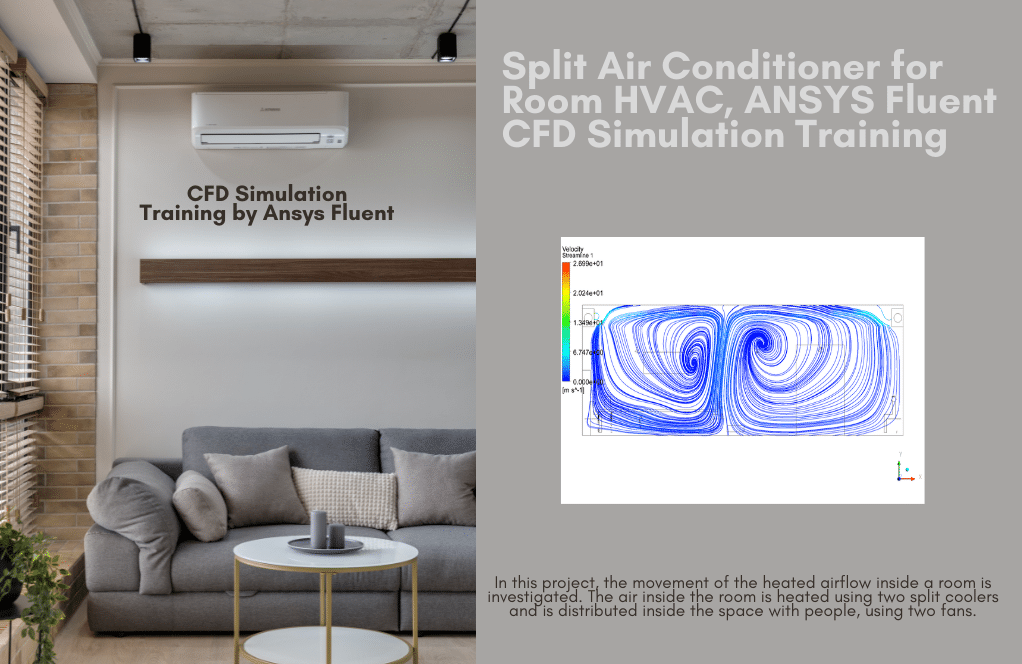

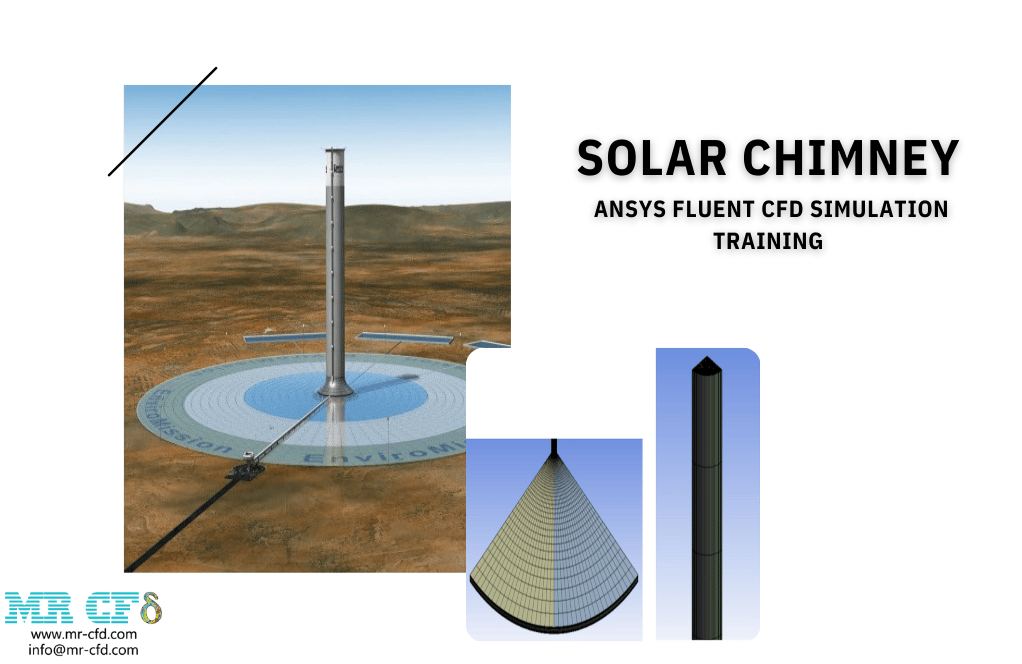

Freeman D’Amore –
This training module was very engaging and practical – seeing how heat distributes through a towel warmer and alters the room temperature was incredibly insightful. The level of detail provided in the simulation, such as the water velocity and temperature settings, made the processes easy to understand. The 3D contours on temperature distribution were especially helpful in visualizing the simulation.
MR CFD Support –
Thank you for your positive feedback! We are thrilled to hear that you found the training module engaging and that the details helped enhance your understanding of the CFD simulation process. It’s great to know that the visualization tools provided, such as the 3D contours, were effective in conveying the simulation results. We appreciate your review and are happy that you benefited from our training module.
Clovis Wiza DDS –
The training for the Towel Warmer ANSYS Fluent CFD Simulation was fantastic. The step-by-step methodology was clear and the results were very insightful. I particularly appreciated the detailed analysis on temperature distribution, which is critical for understanding the efficiency of the towel warmer. Great job on this instructional material!
MR CFD Support –
Thank you for your positive feedback! We’re delighted to hear that the training material for the Towel Warmer ANSYS Fluent CFD Simulation met your expectations and provided you with the clear insights you were looking for. Your satisfaction is our top priority, and it boosts our motivation to continue delivering high-quality educational content. If you ever have more questions or need further support, don’t hesitate to reach out. Thank you again for choosing our training products!
Felipe Franecki –
I am thrilled with the results of the Towel Warmer simulation. The level of detail in the data and visuals is exceptional, providing comprehensive insight into the functionality and efficiency of the design.
MR CFD Support –
Thank you for your kind words! We’re glad to hear that the Towel Warmer simulation met your expectations and provided rich details and insight. If you need further assistance or have more questions, please don’t hesitate to reach out to us.
Dr. Antonina Konopelski –
The simulation looks very comprehensive. Does it consider different materials for the towel warmer, or is it based on a specific one? I would like to know if material conductivity and other properties have a significant impact on the performance in the simulation.
MR CFD Support –
In this simulation, specific material properties have been used for the towel warmer, determined by the settings in the simulation program. The thermal conductivity of the material is an important factor in the device’s heating efficiency and thus in the heat distribution within the bathroom. While the impact of material selection is not explicitly detailed in the case at hand, generally, material properties can significantly affect simulation results and are an important factor to consider in similar CFD analyses.
Dr. Jimmie Boehm V –
The simulation and learning material seem very detailed. While working through the project, I felt well-prepared to handle simulations of similar devices in the future. Understanding the setup and analysis of the heat transfer process in this system was insightful and the provided resources made complex concepts easier to grasp.
MR CFD Support –
Thank you for your positive feedback! It’s wonderful to hear that the material provided in the Towel Warmer ANSYS Fluent CFD Simulation was helpful and that it has equipped you for future work in similar simulations. We always strive to create comprehensive training content that enhances understanding and practical application for our customers. If you have further projects or need assistance, feel free to reach out to us.
Weldon Hickle –
This towel warmer CFD simulation seems very thorough. I’m interested in the heat transfer analysis. Has there been any observation regarding the distribution of temperature on the surrounding air, which could indicate the efficiency of the warmer in heating the bathroom?
MR CFD Support –
In the towel warmer CFD simulation, the temperature distribution on the towel warmer’s surrounding air has been observed. The simulation includes convective heat transfer between the pipe walls and the surrounding air, showing how the towel warmer effectively heats up the area. As hot water circulates through the pipes, heat is transferred to the air in the bathroom, raising its temperature systematically as evidenced by the thermal contours in the results.
Mr. Felton McKenzie –
Outstanding experience learning about the physics behind radiator systems for practical applications, especially about the towel warmer radiator. The approach in converting theory to practical simulations is what stood out.
MR CFD Support –
Thank you for your positive feedback! We are thrilled to hear that our training effectively conveyed the practical applications of radiator systems. Your satisfaction with our approach to transforming theoretical knowledge into real-world simulations means a great deal to us.
Dr. Rashad Tillman MD –
I am thrilled with the level of detail in the Towel Warmer CFD Simulation and the inclusion of heat transfer in pipes. Have the simulation results considered the effect of the material of the towel warmer on the heat distribution?
MR CFD Support –
Thank you for your positive remarks on the Towel Warmer CFD Simulation! The simulation takes into account the thermal properties of the towel warmer material to accurately predict heat distribution, including factors like conductivity and specific heat, to ensure reliable results on the effect of the radiator’s heat on the towels and room temperature.
Prof. Amelia Gorczany DVM –
I was wondering if alternative turbulence models could also be used for this towel warmer simulation, or was the realizable k-epsilon model essential for some specific reason with this configuration?
MR CFD Support –
The realizable k-epsilon model is often chosen for its robustness and accuracy in predicting the flow pattern for a wide range of turbulent applications. However, alternative turbulence models such as SST k-omega or k-omega especially in areas with adverse pressure gradients and separating flows could also be employed to potentially provide different insights into the flow and temperature fields in the towel warmer simulation. The choice of turbulence model can be influenced by the specific characteristics of the flow and the trade-off between computational efficiency and accuracy.
Fletcher Mills IV –
I’m curious about the impact of water flow rate on the efficiency of the towel warmer. Does the CFD simulation explore how different flow rates might affect heating performance?
MR CFD Support –
The impact of water flow rate on the efficiency of the towel warmer is an important aspect that can be studied through CFD analysis. While the simulation you are referring to assumes a constant flow rate of water within the system, to investigate the impact of different flow rates on the heating performance, multiple simulations with varying flow velocities could be set up. These simulations would reveal how changes in flow rate would influence heat transfer and ultimately affect the ability of the towel warmer to heat the towels and the surrounding space effectively.
Heber Bayer –
I’m really excited about the level of detail in the towel warmer CFD simulation. It’s incredible to see how computational modeling can predict the temperature distribution and performance of such a domestic device!
MR CFD Support –
We’re absolutely thrilled to hear that you are excited about the level of detail in our towel warmer CFD simulation! It’s our pleasure to provide high-quality simulations that bring value and insights to our customers. Thank you for your positive feedback, and we can’t wait to support you in your future simulation projects!
Ms. Diana Hansen –
The details on how the water flow and temperature are simulated are fascinating! Great job accurately replicating the function of a real towel warmer in a CFD environment!
MR CFD Support –
Thank you for your positive feedback about our Towel Warmer ANSYS Fluent CFD Simulation training! We are delighted to know that you appreciate the level of detail and accuracy in our simulation. If you have any more questions or need further information, please don’t hesitate to reach out.
Shanna D’Amore –
I’m extremely impressed with the Towel Warmer ANSYS Fluent CFD Simulation training. It clearly demonstrates the practical application of simulation in everyday products like a towel warmer, enhancing the understanding of heat transfer processes. Moreover, the detailed explanation of the methodology, including the thermal boundary conditions and flow characteristics, perfectly illustrates the comprehensive nature of the training. Good job on offering such a well-structured and in-depth learning resource!
MR CFD Support –
Thank you for your positive feedback! We’re delighted to hear that our Towel Warmer ANSYS Fluent CFD Simulation training has met your expectations and provided valuable insights into the heat transfer process in practical applications. Our goal is to provide in-depth and practical CFD training, and we’re glad that you recognize the effort put into structuring the course with clear methodologies and detailed simulations. We appreciate your compliment and hope that our training continues to be a beneficial resource for your learning journey.
Morgan Bode –
This tutorial seems very informative! The specifics on the methodology, such as the flow velocity, water temperature, and the thermal boundary conditions, are especially appreciated. It gives a clear idea of the simulated environment. Looking forward to applying these in my projects!
MR CFD Support –
Thank you for your positive feedback! We’re delighted to hear that our tutorial on Towel Warmer ANSYS Fluent CFD Simulation was helpful for your understanding and upcoming projects. If you need any further assistance or have more questions, don’t hesitate to reach out. Best of luck with your simulations!
Dee Bayer PhD –
I’m extremely pleased with the thorough analysis provided in the Towel Warmer ANSYS Fluent CFD Simulation training. The insights into heat distribution and airflow around the warmer were eye-opening and will greatly benefit my design projects. The well-explained methodology made it easier to follow along. Thank you for such a practical and detailed CFD course!
MR CFD Support –
Thank you for your kind words and positive feedback! We’re delighted to hear that our Towel Warmer ANSYS Fluent CFD Simulation training has provided valuable insights for your projects and that the detailed methodology was beneficial for your understanding. We look forward to supporting you in your future design endeavors!
Prof. Cletus White Jr. –
I’m delighted with how clear the simulation results are. The contours really illustrate the heating performance of the towel warmer in great detail!
MR CFD Support –
Thank you for your positive feedback! We’re thrilled to hear that you found the simulation results clear and informative. It’s great that the contours effectively demonstrated the towel warmer’s functionality. If you have any further questions or need additional information, don’t hesitate to ask!
Dr. Gloria Haley Jr. –
I’ve learned so much from this Towel Warmer ANSYS Fluent CFD Simulation training course! The presentation of the methodology was very clear and helped me understand the simulation process fully. I was able to replicate the steps in my project, and the results were excellent.
MR CFD Support –
Thank you for your kind words! We are thrilled to hear that the Towel Warmer training course was clear and beneficial for your project, and you achieved excellent results. It is always our goal to provide comprehensive and understandable material. We appreciate your feedback and are here to assist you in any future CFD endeavors!
Fernando Satterfield –
This is an amazing real-world application with clear-cut explanations. The idea of simulating a towel warmer with such precision blows my mind!
MR CFD Support –
Thank you for your kind words! We’re thrilled to hear that you found the real-world application and detailed explanations impactful and helpful. Our goal is to provide realistic simulations with precision, and we’re glad it resonated with you.